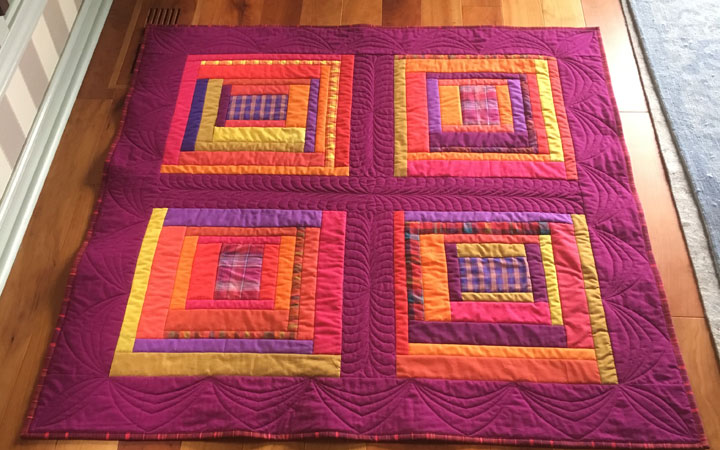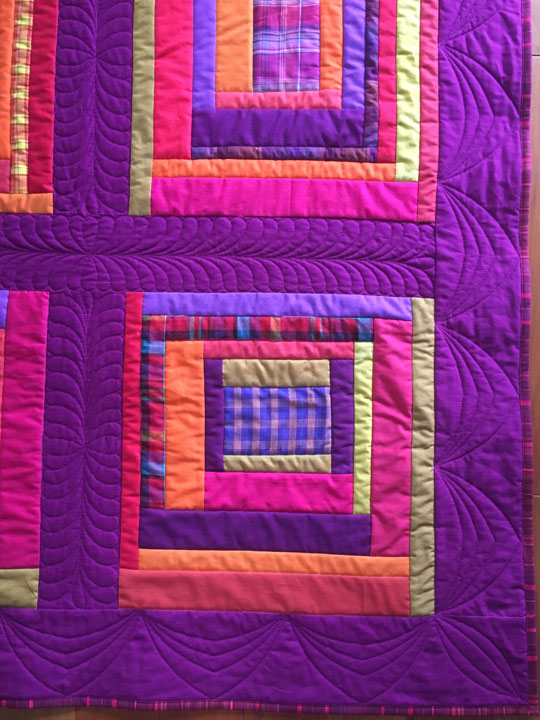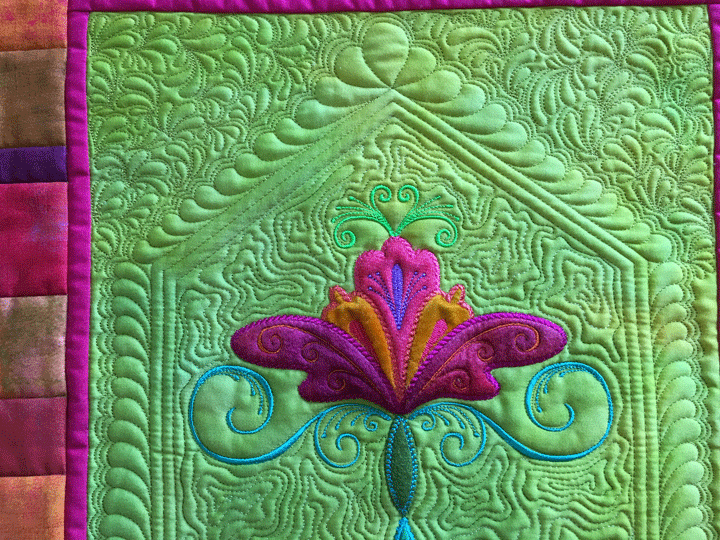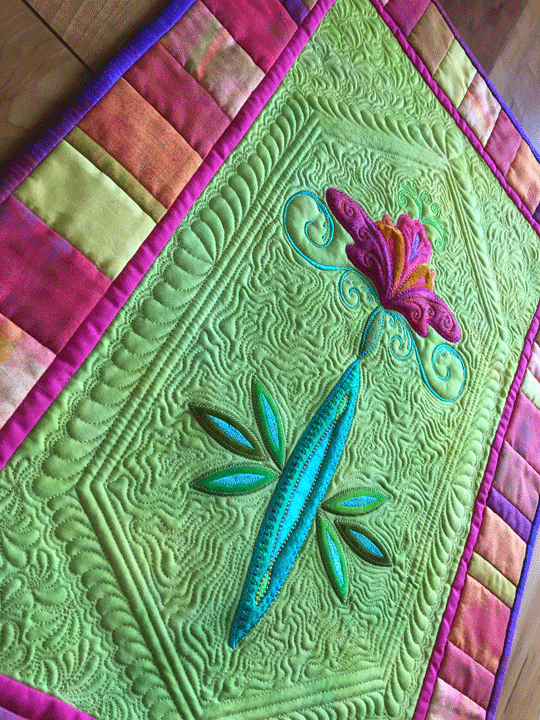October 10th, 2018
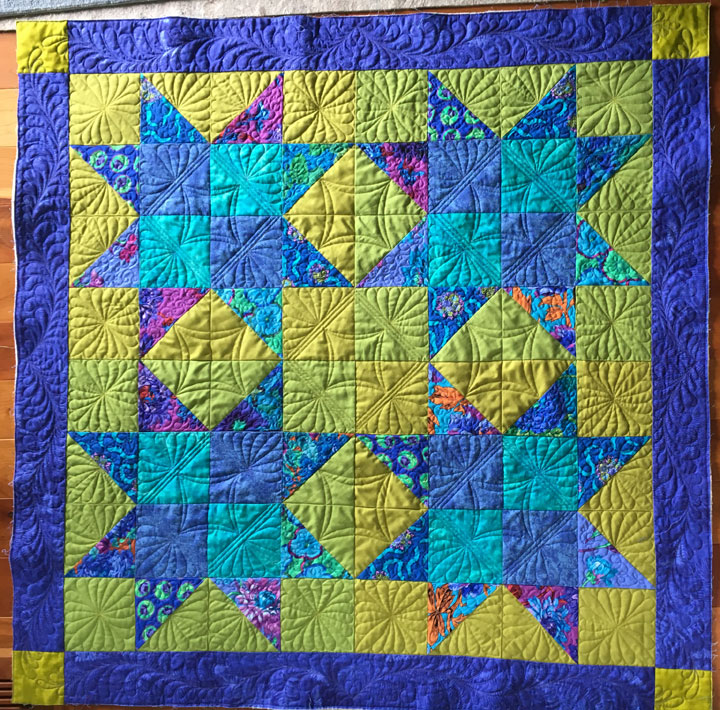
My pledge to myself to use up orphan blocks to make donation quilts has paid off-my first one has been pieced and quilted! I’m very fond of blues/greens/and purples so it was very easy to work on this quilt. I used my PTD ruler starter set for all the ruler work. You can see the ruler work design pretty clearly in the sections made w/solid color fabrics:

…and the same design is used inside the large center blocks inside the stars, although it’s not as obvious because of the print fabrics:

One of the things I love most about ruler work is that it’s easy to create larger secondary designs that are formed by multiple adjacent blocks, as seen below:
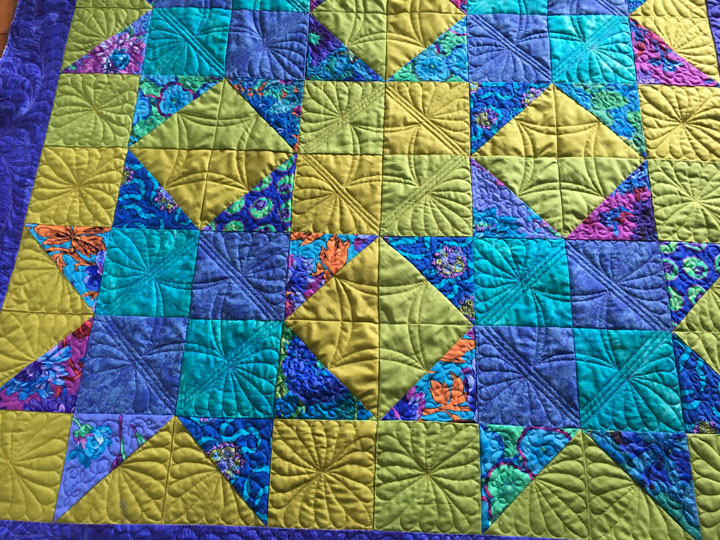
The half triangles and squares along the outermost “pieced section” were filled with featherettes, and the outermost border is a mirror image pair of feathers in each border:
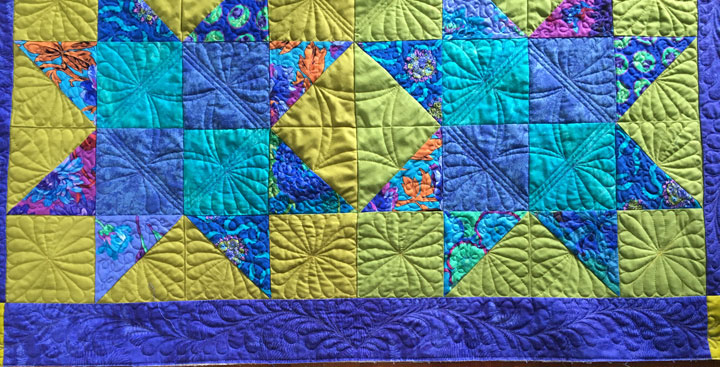
My goal is to piece at least 12 quilt tops over the next 12 months and if I can also get them quilted in that time frame, I would be on the moon!

The back side does not show the quilting well because it’s too busy of a print:
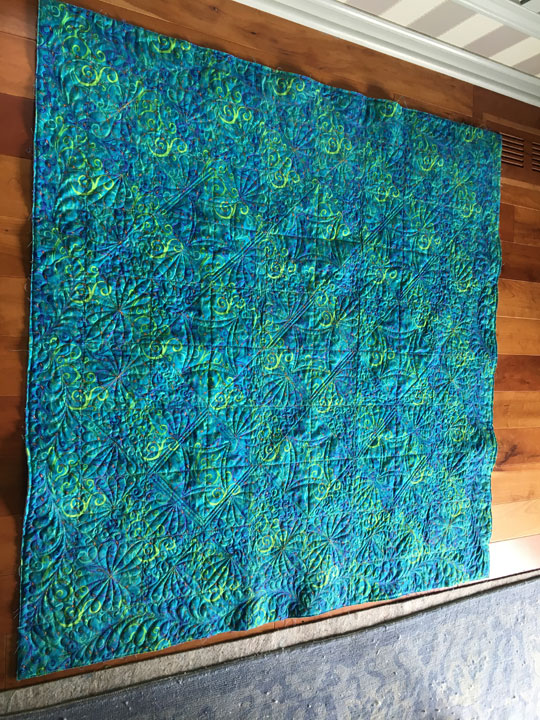
One last look:

Hospice donation quilt #1 for the period of 10/1/18-9/30/19!
Filed under
Free Motion Quilting, Hospice Quilt Project, ruler work on a HDSM.
September 14th, 2018

I think I started making the blocks for the center of this quilt 2 years ago. I remember wondering how long this quilt might take as my father in law had been diagnosed with esophageal cancer about 4 months earlier, and we were spending a fair amount of time traveling to visit family. At the time, I had no idea that other family members would also need help and that would be the real cause of stretching this project out for such an extended period of time. The anniversary of my FIL’s death will be 2 years this December, and so much has happened since then. One thing I like about making quilts is there is always a “background story” for every quilt, the background story being all the memories of the things that were going on in one’s life as stitches were being laid down. This quilt’s story covers a very unique time in my life of elderly parents/in-laws declining and needing help. In many ways, working on this quilt and others during this time has been my therapy. Choosing colors for fabrics and threads, dreaming up different ways to bring shapes and colors together, is warm respite for a worried mind/heart. I’ve said it before and I’ll say it again, thank goodness I learned how to quilt so young! Enough on background, let’s talk about the quilt!

The applique is all machine embroidery applique that was done using an embroidery machine. The shapes were all cut using my Sizzix cutter. This quilt is largely quilted by creating ruler work frameworks in between applique shapes and then filling those in w/free motion quilting. All of the ruler work on this quilt was done using my PTD ruler starter pack. The center 9 blocks have a framework made with dark purple Glide polyester thread and the background was quilted with a black rayon thread by Sulky. I used black for the background because I thought the purple might be too busy for the background fill, but it all seems so subtle to me now that I wonder if I should have used purple for both.
For some reason, the center of this quilt was particularly difficult to move across my machine bed. I still don’t know why that was, but it gave me a bad attitude about quilting this quilt pretty quickly after I’d started it. I set it aside for 2 months just because the thought of quilting is was so unpleasant! I finally decided that if I wanted to have a quilt to enter in our fall quilt show, I’d better get moving. I’m glad I did because once the center was quilted, the rest of the quilting was very fun and went by very quickly.

The triangles that line the outer border of that second zone (the zone above w/the swirly flowers) were supposed to be stitched in that same purple thread. I didn’t realize that I’d forgotten until one entire side was complete and there was no way I was going to rip it out! That part of the quilting design falls flat to me. I find myself wondering it it would have been an interesting frame had it been stitched in the intended purple, but I’ll never know now.
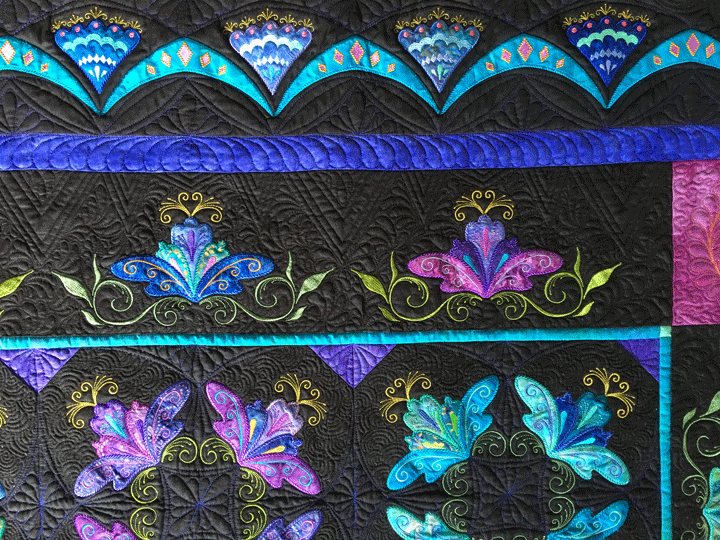
The outermost applique border is my favorite part of the quilting. The quilting in that section went lickety-split. It’s hard to see here, but the ruler work in that zone was correctly done in purple thread. A few more photos:

and

and
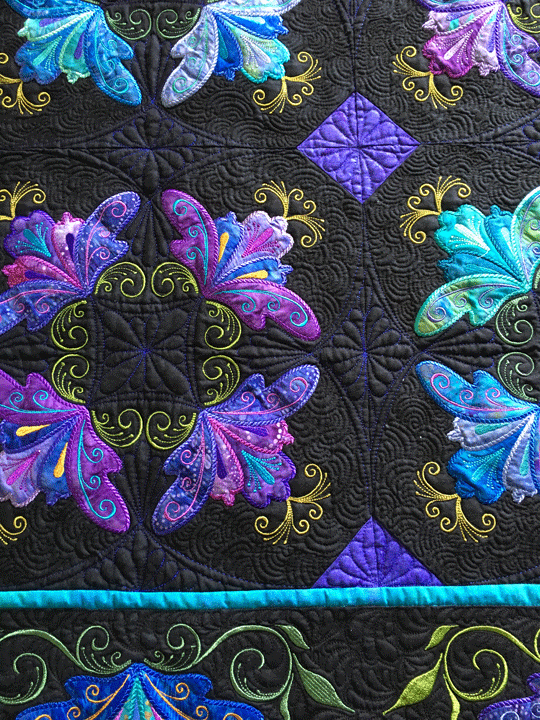
Binding, a hanging sleeve, and label are in my near future…

Filed under
Free Motion Quilting, Machine Embroidered Applique, ruler work on a HDSM.
August 30th, 2018
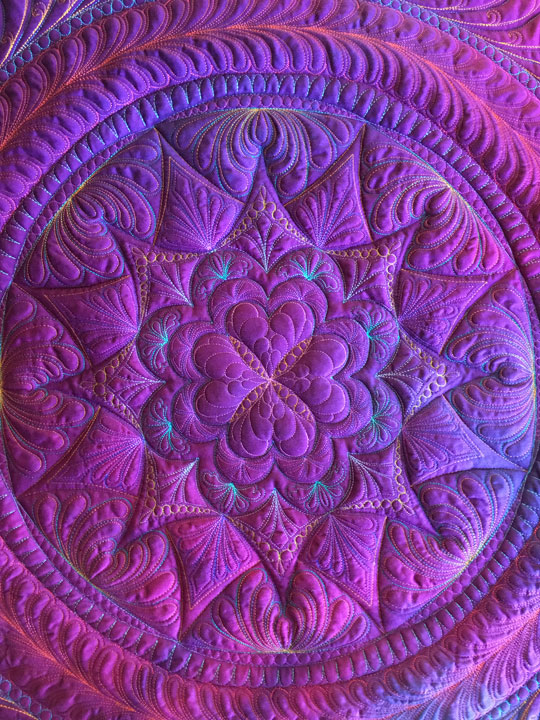
This is the center of a very complex and large feathered wreath. It was created using ruler work, then “decorated” with free motion quilting inside the various “zones” of the spine that were created using rulers. When you have a complex quilted design like this one, using variable levels of trapunto inside different zones will help define those zones better. This is important because it means that you can kind of control how the viewer will perceive the design. On top of that, the work is much easier to do since all of the highly detailed quilting is done before the quilt is in the final quilt sandwich, so you are dealing with a smaller and lighter piece that is easy to move around your machine bed.
This began as a 40 inch square piece of hand dyed cotton sateen. I pinned a piece of scrap batting (Hobbs Tuscany Wool/Cotton Blend) behind the fabric; it was nearly as large as the top because I wanted the entire wreath to have at least 1 layer of trapunto. I know this very wide spine zone is very complex, but it begins very simply, adding layer upon layer of ruler work. To begin, used my traditional 8 lines to create registration marks across the block, then quilted the 3 sizes of the PTD flower templates, as shown below:
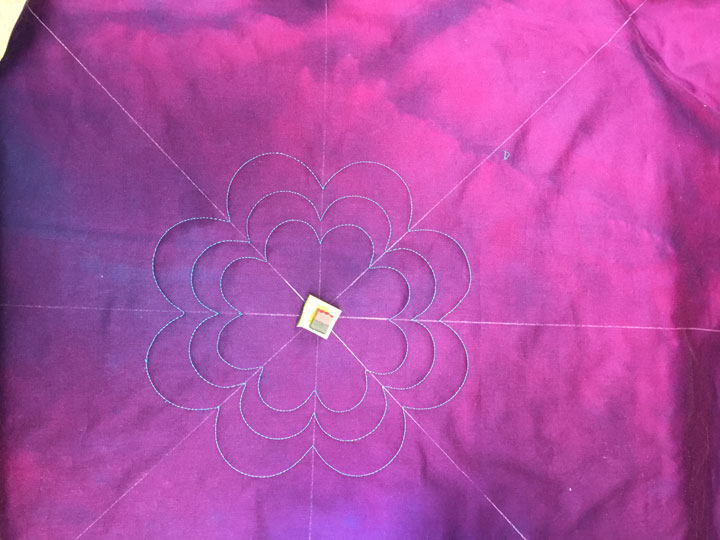
(Note that there is a foam pin anchor holding a pin in the dead center of the block. I used it when I was doing the flower template ruler work, and have left it in place because I may need it later. You don’t have to do this, I just do.) Next up, I used arc rulers to create a series of tapered channels that spring from the largest flower template design, (maroon polyester thread), then another series of tapered channels that spring from the first set of tapered channels, (gold polyester thread), and then used 2 different arc rulers to create a set of tapered channels that encircle the largest triangles (aqua polyester thread). Here’s what the design looked like at this point:

One of the challenges in working on a multi-colored base fabric is choosing thread colors that will show. I try to save my high contrast thread colors for the areas where I really need the design to pop. There were so many layers to this design that it would take to long to post it all here. In this next shot, I’ve added 3 concentric circles around that earlier design. Do you see a white soap line of a circle that encircles the entire thing? That is my temporary boundary line that I’ll use to guide me as I stitch the plumes along the outer edge of the circle. I actually had to draw that boundary before I did the stitching of the other circles so that I could figure out how wide my spine zone could ultimately be. I used my oversize set of Westalee Circles on Quilts templates for some of these circles. For others, I used my PTD shallow arc rulers. I can get away with this because I know that all our PTD arc rulers are cut from circles (as opposed to arcs), so I can use a PTD 30 arc to stitch/draw a 30 inch diameter circle, a 24 arc to stitch or draw a 24 inch diamter circle, etc.
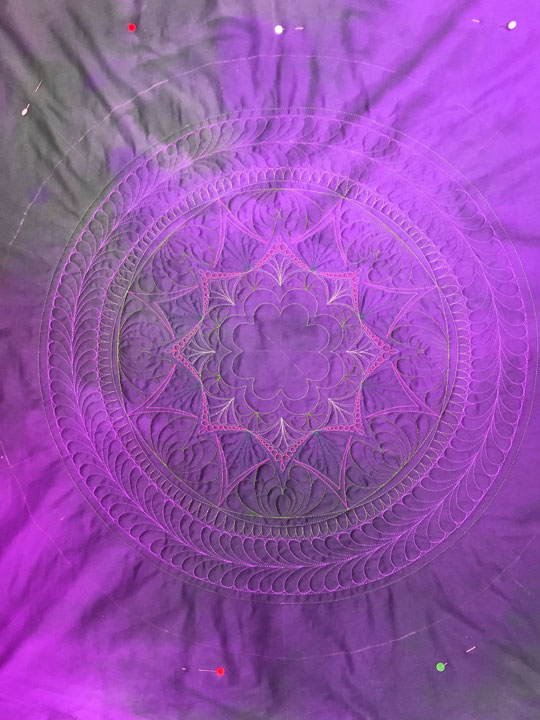
You can see that I’ve begun a lot of the fill-in work in the shot above. I try to avoid much hyperquilting until I’ve got a fairly even expanse of fill-in, but sometimes I can’t help myself. In this next shot, I’ve added the outermost plumes. The feathered wreath is a 30 inch diameter feathered wreath.
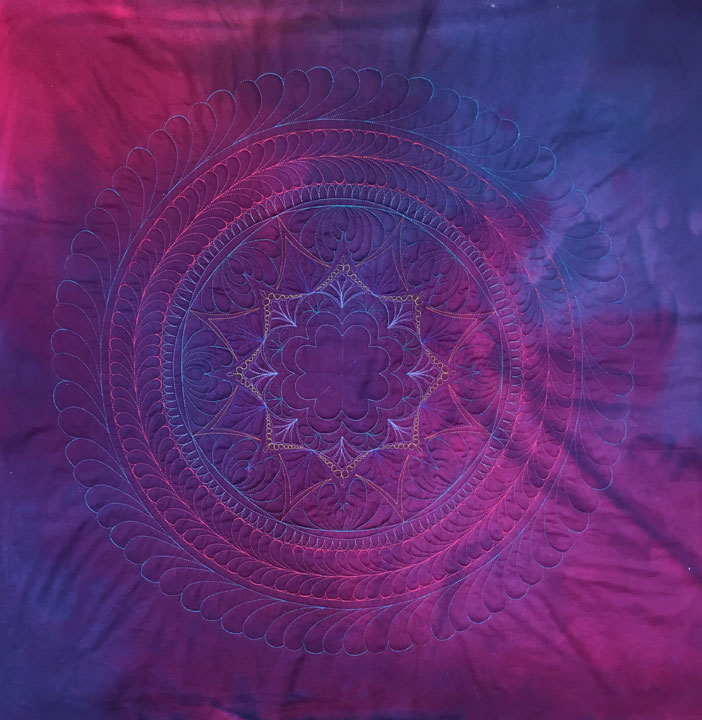
I am now in a position to add a lot of hyperquilting. I need to have all the hyperquilting completed before I can begin adding additional layers of batting to select portions of the wreath. In the shot below, you see a close up of the center of the wreath once the hyperquilting has been added:

What I’m hoping you can see are areas of “excess” along the top and bottom of the wreath. When you do this much hyperquilting, it really hightens the contraction of the quilt that occurs w/dense quilting. When you’re working in a circular design like this, that contraction “traps” portions of the quilted design. It’s at this point in the process where I start to have heart palpitations and worry that I’ll never get it to lay flat, but I’ve done this so many times that I can usually calm myself from worrying too much! This next shot shows how “loose” and “excessive” the fabric outside the wreath appears:

Do you understand now what I meant about the heart palpitations?! Trust me, the quilted wreath itselkf does not come close to lying flat either, so there’s far more to worry about than what this photo illustrates!
Since the wreath is quilted, I cut away all the excess batting that falls outside the wreath. Here’s what the back of the top looked like at this point:
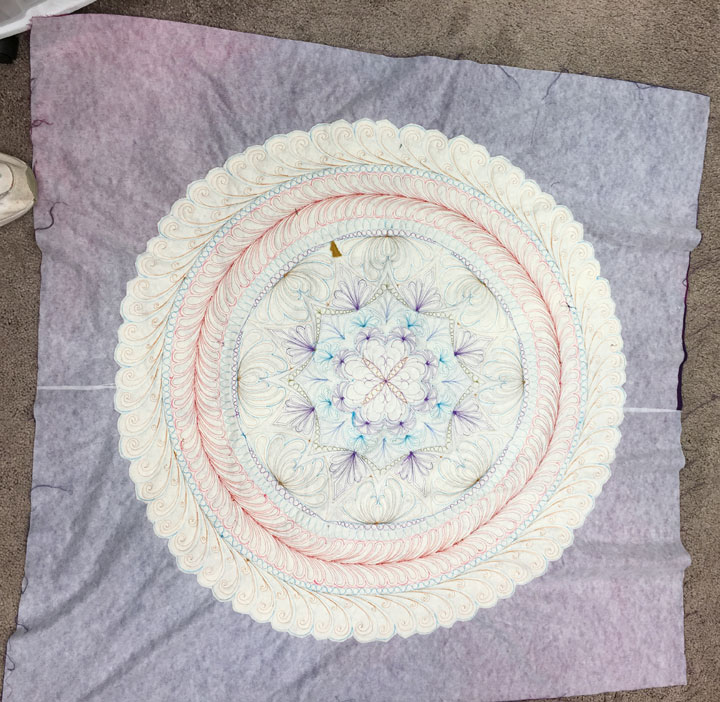
So, at this stage, there is one layer of batting underneath the entire wreath. Know that the white stuff you see on the backside of the fabric is a layer of lightweight fusible interfacing (Pellon 845FW Designer’s Lite, to be specific.) You don’t need to do this when you’re creating a trapuntoed project. The only reason I am using it is the fabric is a cotton sateen. This is a beautiful fabric but it is a twill and can sometimes be a bit of a “shape shifter,” if you know what I mean! For that reason, I now back it with fusible interfacing so it will behave more consistently. This is a super lightweight interfacing that will not alter the hand of the fabric.
I’m ready to add some extra batting to focal areas of the wreath. I start by tracing the medium size flower onto a scrap of Quilters Dream mid wt polyester batting:
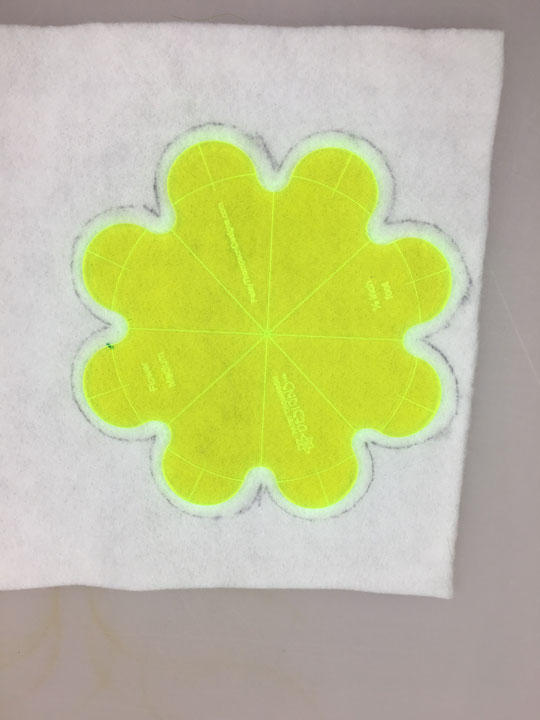
Note that I traced that shape using a donut on my pen. You need to do this for a shape like this because the ruler foot adds 1/4 inch to the outer edge of the stitched template. I then decided I wanted to add a layer to one size of trapezoid in the wreath, so I laid a piece of tracing paper (doctor’s exam table paper is perfect for this kind of work), and did a rough trace of that shape:
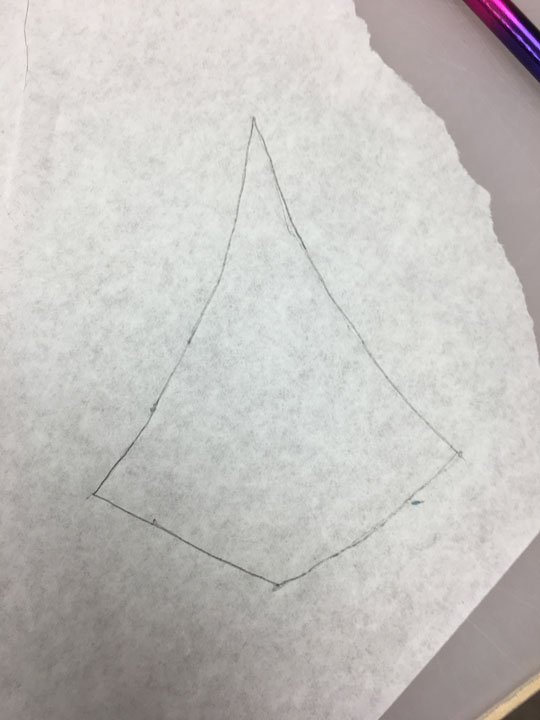
I used my rotary cutter to cut out 2 of those shapes at a time, so it went very quickly. In this next shot, you can see that I have attached the flower shape of batting and the trapezoid shapes to the back side of the wreath. A simple swipe of the glue stick is all you need to use to adhere these:
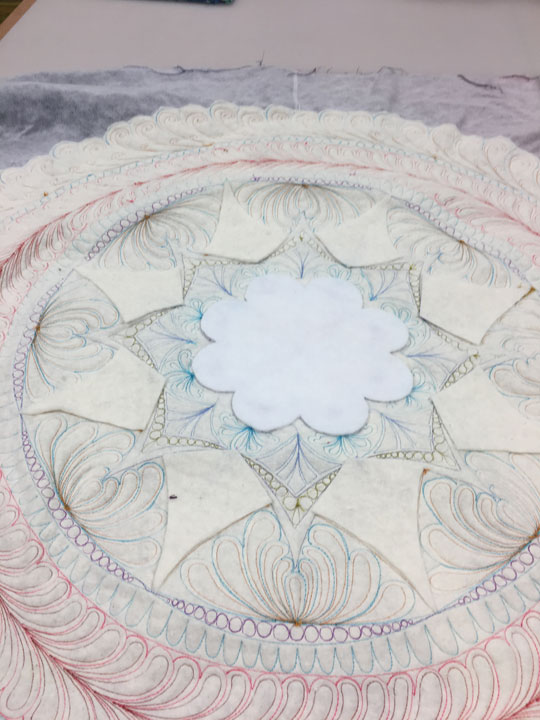
I normally add trapunto layers to areas where I want to draw more attention, but for this wreath, I also had to consider construction issues. There is a zone of the spine where a continuous feather is stitched. I don’t really want to draw attention to this area, but because the quilting is so dense there and it is bounded by 2 concentric circles, the constriction caused by the quilting is “trapped.” This will cause this zone to kind of “balloon outward” if I don’t do something, so I need to add an extra trapunto layer to this zone. In the shot below, you can see that I’ve traced 2 concentric circles onto another scrap of batting (this is the thinnest version of Quilters Dream polyester):
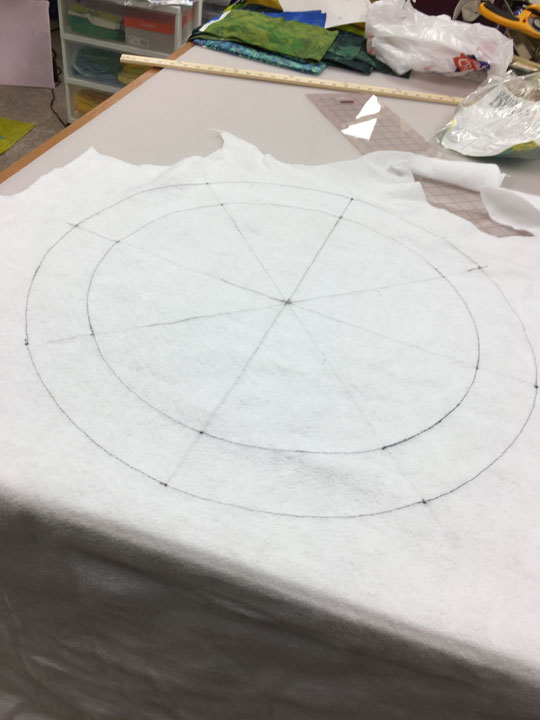
Once I cut those out, I was ready to add it to the backside of the top, as shown below:
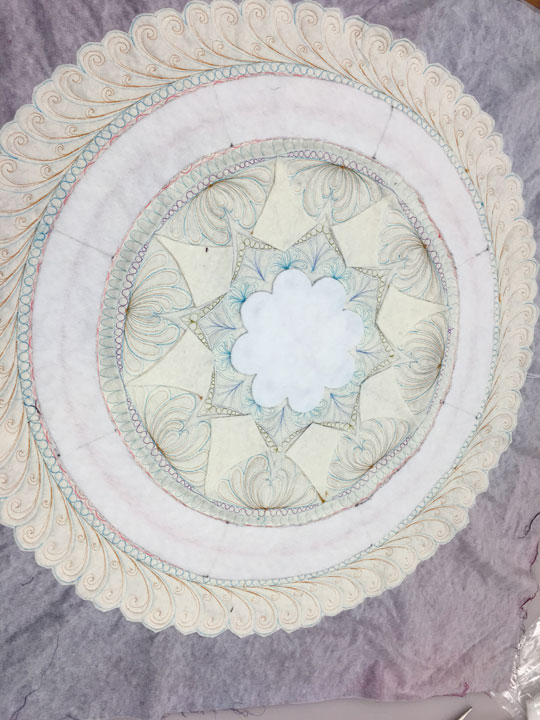
Once placed into the final quilt sandwich, (with another layer of Hobbs Tuscany Wool/Cotton Blend batting underneath the entire thing), I was ready to begin quilting. Here are a couple shots of the wreath once zones had been outlined with invisible thread in the top needle:

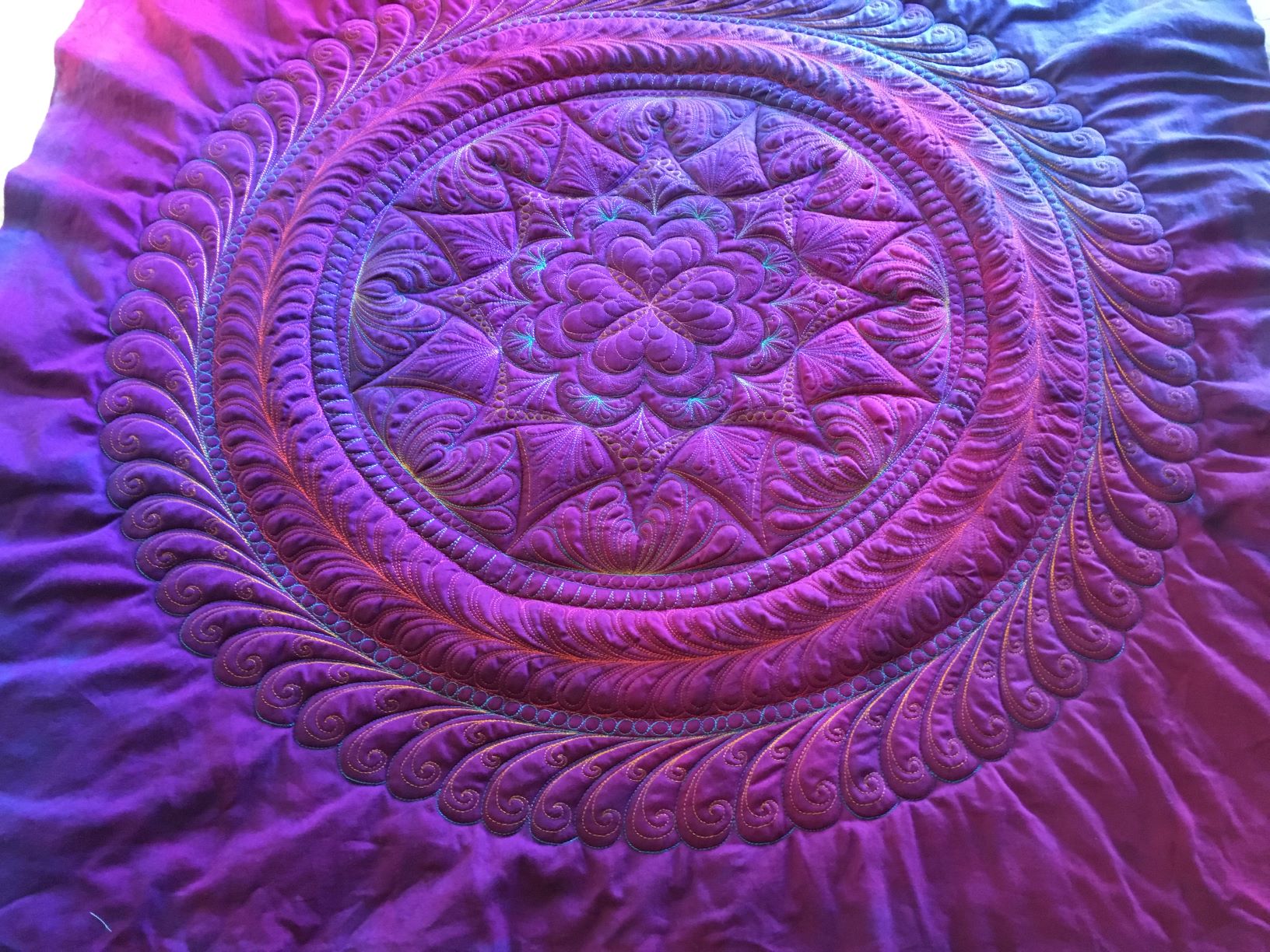
Can you see that the outer zone w/the continuous feather still balloons out a bit, in spite of that extra layer of trapunto batting? I think I’m going to have to go in and outline all those plumes with invisible thread. More to come later….
Filed under
Free Motion Quilting, ruler work on a HDSM, Trapunto.
